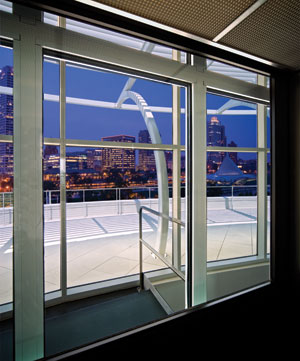Fire-Rated Glass and Framing Deliver Design Goals
 |
Fire-rated, impact-safety rated transparent wall panels provide attractive glazing in highly visible locations. Photo courtesy of Technical Glass Products |
The first step is to understand fire-rating terminology, such as "hose stream test," "impact safety" and "positive pressure." But most important is appreciation of the distinction between "fire protection" and the more rigorous "fire resistance," which will drive each choice of a fire-rated glazing product. (See below.)
Fire-Rating Tests and Terminology
Design professionals should check manufacturers' product literature for fire-ratings. Common phrases in the fire-rated glazing field include:
Fire Protection Rating. The designation indicating the duration of the fire test exposure to which a fire door assembly or fire window assembly was exposed and for which it successfully met all acceptance criteria as determined in accordance with test standards such as NFPA 252 / NFPA 257 / UL 9 / UL 10C.
Fire-resistance rating or heat barrier rating. Fire resistance is a more rigorous rating than fire protection and is generally required for wall assemblies such as transparent wall panels. Also known as a heat barrier, it is expressed as a unit of time, generally in minutes or hours, that materials or assemblies have withstood a fire exposure as established in accordance with the test procedures such as NFPA 251 / ASTM E-119 / UL 263. This rating tests a product's ability to block the transfer of conductive and radiant heat from a fire.
Why Ceramic Glass is Different |
Manufacturers produce ordinary float glass by heating a mixture of sand and modifiers until it melts; they then cool it quickly to become glass. It is named "float" glass because it is made by floating molten glass on a bed of molten metal. Because of the rapid cooling, the particles in the liquid state can't return to their original crystalline arrangements. Instead, they settle randomly. The result is that glass is known as an amorphous (literally "without shape") material. Amorphous glass is brittle because atoms cannot slip past each other to relieve stress from a surface flaw or crack. Ceramic glass is manufactured by overheating glass so that its amorphous structure is transformed into a fine-grained crystalline arrangement. This crystalline material prevents cracks and can hold together under high heat. Glass-ceramics are at least 50 percent crystalline after they have been heated. In some cases, the final product is more than 95 percent crystalline. While ordinary glass has the desired features of low color, high clarity, a smooth surface and ability to be manufactured in large sizes and shapes, it fails building codes that call for fire-rated glazing. It shatters at approximately 250 °F (tempered glass also cracks at relatively low temperature, about 500 °F)-well below temperatures of many fires-shatters on impact, transfers heat and will not block a fire's spread. Ceramic glass, however, has the hardness and fire protection of ceramics plus the close appearance of floatglass. Fire-rated glass can remain intact up to 1600 °F or hotter for varying periods depending on the specific product. |
Â
Fire ratings. Fire-rated glazing is typically rated from 20 minutes to 3 hours. The rating reflects the amount of time the material is anticipated to remain in place to help stop the spread of fire and smoke. Fire ratings are determined by a series of tests conducted by independent testing facilities, such as Underwriters Laboratories (UL.) The lab installs samples of the glass and framing in a wall assembly. This assembly is then subjected to specified test standards that include two required elements: a "fire test" and a "hose stream test."
Fire test. In the fire test, the glass and framing assembly is heated in a furnace following a specified time-temperature curve. After five minutes, the temperature reaches 1,000 °F and increases to 1850 °F at 120 minutes. To earn a rating, the standard generally requires that: 1. the window or door assembly must not separate from the wall in which it was installed for the duration of the test; 2. flames cannot appear on the unexposed surface of the assembly; 3. the glazing material edges must not separate from the glazing frame; and 4. no openings shall occur in the door or window assembly.
Hose stream test. The fire hose stream test shows how hot glass will react when hit by water from a fire hose, or perhaps from just a sprinkler. If nearby sprinklers activate during a fire, the "shocked" glass could shatter and vacate the frame within only a few minutes, thus allowing the spread of deadly flames and smoke.
Within two minutes of completion of the fire test, the hot glass and framing is subjected to a hose stream test. The purpose of this test is to evaluate the integrity and overall reliability of the glazing unit.
In the United States, the hose stream test is required for all fire ratings of 45 minutes or greater. Canada requires the test for all fire ratings. The hose stream test is an integral part of many fire testing standards such as ASTM E 119.









